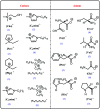Assessment of the toxicity and biodegradation of amino acid-based ionic liquids
- PMID: 35520906
- PMCID: PMC9062378
- DOI: 10.1039/c8ra06929h
Assessment of the toxicity and biodegradation of amino acid-based ionic liquids
Abstract
Amino acid-based ionic liquids (AAILs) are generally thought of as green solvents and widely used in many regions without systematic assessment of their effect on the environment or human health. In this work, a series of AAILs with different cations and amino acid anions were prepared and characterized, after which their microbial toxicity, phytotoxicity, and biodegradability were evaluated. The results showed that not all AAILs had low toxicity against microorganisms and that some AAILs were highly toxic towards the targeted microorganisms. The phytotoxic effect of the AAILs on rice (Oryza sativa L.) further demonstrated that AAILs should not be presumed to be non-toxic to plants. Moreover, the biodegradability tests showed that majority of AAILs were not satisfactorily biodegradable. In summary, not all AAILs are non-toxic or biodegradable, and their effect on the environment and human health must be assessed before their mass preparation and application.
This journal is © The Royal Society of Chemistry.
Conflict of interest statement
The authors declare no conflicts of interest.
Figures



References
-
- Steinruck H.-P. Wasserscheid P. Catal. Lett. 2015;145:380–397. doi: 10.1007/s10562-014-1435-x. - DOI
LinkOut - more resources
Full Text Sources

